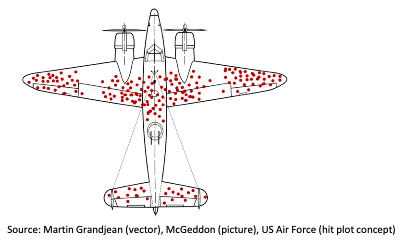RESOURCES
BLOG
Join in the community forum! The thINK blog is a place for community members to share their opinions, best practices, successes, and challenges. Add your comments to the blogs published here or write a blog and we’ll post it for you.

What Aren’t You Seeing?
Do you ever wonder if you might not be getting the full picture of something? It could be regarding your production floor data, customer satisfaction surveys, or perhaps the sources for images that a client wants to use, which were generated using artificial intelligence (AI). A military study from World War II provides some surprising insight into what you might be missing.
Survival Bias
Take a look at this image of a two-engine World War II bomber (it’s a Lockheed PV-1 Ventura for you aviation nerds). The red dots indicate where returning bombers had been hit by enemy gunfire. Does anything stand out? You might notice that the engines and the cockpit are untouched, and that most of the damage is to the wings and the tail.
Figure 1: Damage Pattern on a World War II Bomber

This image (well, actually a hypothetical reproduction of the damage pattern) comes from a World War II-era, US Air Force study that tracked the damage done to returning bombers. The study identified all of the places where these bombers had been hit by enemy gunfire. Initially, the researchers thought that this meant that they should reinforce the armor in the spots that were most commonly hit. Then someone suggested that nothing at all should be done in those spots, and that the most valuable spots for more armor would be in the places that had not been hit.
The point was that the planes in the study had returned, despite the damage that they had suffered. It would be better to increase the armor in the weak spots that had led to the loss of a bomber, but, of course, they did not have any data from the planes that had been shot down and never returned, because, well, they never returned.
This phenomenon, which is known as “survival bias,” is relevant to production printing sites in the following ways:
Production floor data: Where do resolvable bottlenecks reside in your production workflow? They may not be obvious in your workflow system reporting data because shop floor employees may have developed complicated workarounds, which, though they work, are not contributing to ongoing automation efforts. Interviews with production floor employees can sometimes reveal the lengths to which they are going to get their work done.
Customer satisfaction: Have you conducted a customer satisfaction survey? It is extremely likely that some dissatisfied customers will have given up on your operation entirely and will refuse to respond. This is an important constituency for you to understand—wouldn’t you like to know what they would say? It may be hard to reach out to customers who have dropped out of touch for one reason or another, but they may hold the key to issues that you can resolve.
Artificial intelligence: A sizeable concern when using AI is that you do not necessarily know what important pieces of data might have been included or left out of the data set that fueled an AI-enabled conclusion or illustration. Unauthorized use of copyrighted images, personal likenesses, or commercial brands are possible. So is the exposure of private or sensitive information gleaned from the data that the AI process was trained on. The lack of clear sourcing for AI-developed text and images poses significant challenges not only regarding copyright, but also in regard to credibility.
Conclusion
Production floor data and customer satisfaction surveys can be excellent ways to help your business learn and improve. Regarding AI, the newness of the technology and the rapidity of its implementation pose some difficult questions about copyright, image ownership, and bias or error in the dataset. Yet particularly in regard to companies that have control over libraries of documents (such as publishers, designers, illustrators, and marketing firms, in other words, those responsible for the brand materials of their client companies), there is an opportunity to be at the forefront of AI implementation. These types of companies are well-positioned to avoid the pitfalls of AI tools that draw from uncurated databases. Instead, they can focus their AI efforts on identifiable sources. As that World War II study shows, you need to be careful about taking the data you receive at face value.
Author bio: Jim Hamilton of Green Harbor Publications (www.greenharbor.com) is an industry analyst, market researcher, writer, and public speaker. For many years he was Group Director in charge of Keypoint Intelligence’s (formerly InfoTrends’) Production Digital Printing & Publishing consulting services. He has a BA in German from Amherst College and a Master’s in Printing Technology from the Rochester Institute of Technology.
